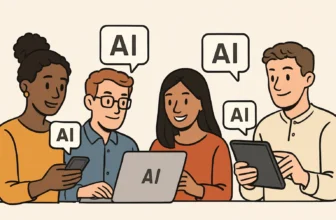
Why AI is the Unsung Hero in Disaster Aid
Did you know that AI can now predict flood zones with over 85% accuracy—before a single drop of rain falls? Crazy, right? We used to think of artificial intelligence as something out of a sci-fi movie, but now it’s *boots-on-the-ground* when it comes to real-world disasters.
Here’s the deal: Disasters strike hard and fast, and for those of us in the non-profit or social impact world, it can feel downright overwhelming. Hurricanes, earthquakes, wildfires—when you’re scrambling to find resources, get aid to the right people, and communicate with partners and governments… well, it’s like trying to juggle flaming swords. Blindfolded. And upside down.
I remember talking with a colleague during last year’s wildfire season. She was crying on Zoom, just worn to the bone trying to help evacuate people while tracking where relief supplies were stuck. These are real people facing real emergencies—and that’s exactly where AI disaster recovery tools have quietly stepped in to work magic.
So, how exactly is AI helping make disaster recovery smarter and faster? Let’s break it down:
- Predicting disasters before they hit: Machine learning models now analyze satellite imagery, weather patterns, and historical data to actually *forecast* threats. That means we can mobilize help **before** tragedy strikes—saving time, money, and lives.
- Targeted emergency response: AI-powered mapping tools like NASA’s Disaster AI identify high-risk zones and damage hotspots within hours. No more sending supplies to the wrong area or playing telephone with outdated spreadsheets.
- Chatbots & smart communication: Tools like WhatsApp-integrated AI responders are answering people’s SOS messages in real-time, even when call centers are flooded. One NGO told me their AI chatbot handled over 100,000 queries during a cyclone crisis!
How can YOU bring AI into your organization’s relief efforts?
- Start simple: Platforms like IBM’s OpenScaling or Google’s AI for Social Good offer tools and resources just for non-profits.
- Partner up: You don’t need to become a coder! Collaborate with tech orgs or universities offering AI partnerships for humanitarian causes.
- Train your team: Workshops and free courses (like those from Coursera or UNDRR) can help your staff understand how AI works in disaster scenarios and how to leverage it with confidence.
Look, AI isn’t a magic wand, but it is a game-changer. As disasters grow in frequency and ferocity, AI gives us an edge we just didn’t have before. It helps us move faster, act smarter, and—most importantly—serve people better.
The best part? You don’t have to be a tech whiz to use it. With the right tools and the right support, your mission can go further, reach deeper, and make recovery more human and more hopeful. So, are you ready to let AI help you do more good?
Enhancing Prediction and Early Warning Systems
Did you know? A single day’s advance warning before a natural disaster can reduce damage and loss by up to 30%. Yep, just 24 hours could be the difference between chaos and control. Wild, right?
If you’ve ever been caught off guard by a storm, earthquake, or any kind of natural disaster, you know that sinking feeling in your stomach. That “I wish we’d known sooner” moment. For nonprofits and responders on the ground, late warnings mean scrambling to mobilize, risking lives, and being forced into reactive mode instead of proactive planning.
Truth is, traditional prediction methods just can’t keep up anymore. Climate change is making everything less predictable—bigger storms, longer droughts, faster floods. And the old-school ways of tracking weather patterns and seismic activity? They’re useful, but they’ve got limits.
So what’s the game-changer? AI-powered prediction tools.
Here’s where things get exciting. Artificial Intelligence, with its mind-blowingly fast data crunching and pattern recognition, is stepping in to shake things up. AI can sift through terabytes of satellite imagery, historical weather patterns, and real-time sensor data—faster than you can say “flash flood”—to predict what’s coming and when.
One cool example? During recent hurricane seasons, AI-driven models actually predicted landfall locations and storm intensities with more accuracy than traditional forecasts. In fact, IBM’s Watson has been used to analyze hurricane trajectories and issue earlier warnings in the Caribbean. That meant shelters were opened sooner, evacuations were more effective, and a whole lot of chaos was avoided.
I worked with a coastal nonprofit last year that started using open-source AI weather prediction software. Before, they had about 6 hours’ notice before a flood. Now? They get alerts up to 48 hours in advance. That’s two entire days to prepare evacuation plans, alert families, and secure supplies. Complete game-changer.
What can *you* do to level up your early warning strategies?
- Explore tools like Google’s AI-based flood alerts: These are already active in parts of India and Bangladesh, and expanding globally. They’re free and easy to integrate into your communications.
- Partner with universities or data-minded orgs: Many research groups are eager to collaborate on real-world disaster prediction initiatives using AI models.
- Start simple with automated monitoring: Set up AI alerts using platforms like Earth Engine or APIs from government meteorological agencies. You’ll get faster insights with minimal tech set-up.
The bottom line? You don’t need a Silicon Valley budget to get started. There are tons of accessible, community-focused AI tools out there today. And with the stakes this high, every extra hour of warning matters—a lot.
So let’s not wait for the next “unprecedented” storm to catch us off guard. With the right tech, a little training, and a dash of bold thinking, we can turn what used to be reactive disaster response into calm, coordinated action.
Early warnings save lives. AI just helps us hear them earlier. 💡
Optimizing Resource Allocation During Emergencies
Did you know? In many disaster zones, nearly 30% of relief supplies go to areas that don’t need them most—while others are left stranded without essentials like clean water or medical aid. Wild, right? And heartbreaking, honestly.
If you’ve ever worked in the thick of emergency relief—whether it was a hurricane, flood, or wildfire—you know the chaos. The adrenaline. The scramble to get help to the right place at the right time. And you’ve probably also felt that mix of frustration and helplessness when trucks of food or medicine show up… but in the wrong location. Meanwhile, 20 miles away, people are still waiting.
That problem? It’s not a lack of compassion or effort. It’s a massive coordination puzzle. And the old-school systems? Well, they’re just not cutting it anymore.
So, where does AI come in?
Imagine having a digital brain that can scan weather data, road closures, shelter capacity, resource inventories, and even social media distress signals—all in real time. Now imagine that brain telling you: “Send 100 blankets here, 500 water bottles there, and hold those medical kits for a clinic opening up tomorrow.” Sound like a superhero? That’s pretty much what AI is doing for logistics.
Smart algorithms now analyze live crisis data to prioritize deliveries, reduce duplication, and reroute resources on the fly. I recently heard about a nonprofit working flood relief efforts that used an AI-powered map tracking system during monsoon season. The result? Supply trucks were rerouted in real-time away from washed-out roads and toward the most impacted villages—cutting delivery delays by almost 50%. Incredible!
Here’s how you can make the shift:
- Try an AI logistics tool: Platforms like One Concern or Palantir Foundry offer predictive modeling and resource optimization specifically built for disasters. Some nonprofits even partner with local universities to build lightweight custom solutions.
- Map your existing assets: Before the next emergency, catalog your shelters, vehicles, supply stockpiles, and response teams. AI thrives on data—give it what it needs to deliver precision.
- Train your team early: Don’t wait until a disaster strikes. Set up mock scenarios with your staff to test the tech in practice. It helps build trust and agility.
I totally get it—tech can feel overwhelming. Especially in the middle of a crisis, when emotions are high and stakes are even higher. But when it works? It saves lives. And it helps you do what you do best: care, act, and respond with impact.
So let’s reimagine emergency relief together—not as a reactive scramble, but as a smart, compassionate system that learns, adapts, and delivers where it truly matters. The tools are here. Let’s use them.
Streamlining Communication in Crisis Situations
Did you know that during natural disasters, more lives are put at risk due to delayed communication than from the initial impact itself? Shocking, right? But when you think about the chaos — phones down, internet sketchy, panic spreading faster than wildfire — it makes sense. A few missed messages or inaccurate updates can literally mean the difference between life and death.
For nonprofits and relief teams, that’s the nightmare. You’ve got people who need help. And you’ve got teams ready to give it. But somewhere along the way, the message gets lost. Maybe cell networks are overloaded. Maybe someone’s trying to translate critical info into five languages at once. Or maybe the system is just outdated. Whatever the cause, communication gaps can grind relief efforts to a halt.
Enter AI — the unsung hero of coordinated chaos
Here’s where things get exciting (and actually hopeful). AI-powered communication tools are stepping in and saying, “Hey, let me take care of that.” I’m talking real-time language translation, automated updates, AI chatbots that don’t sleep, and decision-making tools that prioritize which messages go out first based on urgency. Smart, right?
Take something like a wildfire situation. People are evacuating, phones are buzzing with mixed messages, and not everyone’s on social media. Some may not even speak the dominant language of the area. In recent wildfires, AI-driven chatbots (like Google’s crisis response tools and Microsoft’s AI for Humanitarian Action initiative) have actually been deployed to provide instant, clear, multilingual info — things like:
- Safe evacuation routes
- Air quality alerts
- Emergency shelter locations
These bots are fast, tireless, and don’t glitch out under pressure. One story that sticks with me is from a California nonprofit that added an AI chatbot to their emergency site. Within hours of a wildfire breakout, that bot had answered over 10,000 inquiries — in English, Spanish, and Tagalog. That’s 10,000 people who got critical info instantly instead of waiting on overloaded hotlines. Incredible, right?
So what can you do?
If your organization is working in disaster response or relief — or even if you’re just dipping a toe in — it’s time to consider adding AI communication tools to your protocol. Here’s how to start:
- Evaluate your current communication channels. What’s working? What’s too slow?
- Research AI-driven platforms. Tools like WhatsApp chatbots, Google’s Crisis Map, and Twilio’s programmable messaging can integrate with your systems and scale up instantly in a crisis.
- Build partnerships now. Work with tech developers or AI specialists to set up these tools long before a disaster hits.
Honestly, I get that all this tech stuff can feel overwhelming — especially when you’re already juggling donations, logistics, and ground teams. But here’s the thing: AI doesn’t replace the heart of your work. It amplifies it.
And in a crisis, a few automated messages could free up your team to do what humans do best — help people, hold hands, make decisions, and lead with empathy.
The future of disaster relief is smart, scalable, and yes — powered by AI. Let’s make sure communication isn’t a barrier, but a bridge.
Empowering Ground-Level Relief Workers with AI
Did you know that in major disasters, communication blackouts alone put *over 30%* of field teams at serious risk in the first 48 hours? Wild, right? When everything’s crumbling — literally — ground-level relief workers are the ones braving the chaos. But too often, they’re doing it with outdated maps, patchy phone signals, and a whole lot of guesswork.
Now, I don’t know about you, but just thinking about someone running into a collapsed building without knowing if a second aftershock is coming gives me chills. And unfortunately, that’s not rare. I’ve talked to volunteers who’ve driven into flooded villages with no idea if a bridge still stood or if families were even still there. They were flying blind.
Here’s the thing: these amazing people — the boots-on-the-ground, go-anywhere, “let’s just do this” heroes — deserve better. This is where AI steps in, and honestly, it’s kind of incredible what it can do.
The Power of AI on the Ground
Imagine giving your field teams instant access to live drone footage, satellite maps that update by the hour, and predictive analytics showing the safest evacuation routes. I’m talking about real-time situational awareness — not the kind where you stare at a glitchy GPS pin, but the kind where you *know exactly* where damaged roads, shelters, injured people, and relief supplies are, in that moment.
One standout example? During a massive earthquake response operation in Indonesia a few years ago, humanitarian teams used AI-powered image-recognition through drones to scan destroyed areas. Within hours (yes, *hours*), they’d identified structurally sound buildings for temporary medical posts and flagged red zones where aftershocks had destabilized roads. That used to take days of dangerous manual scouting. The change wasn’t just dramatic, it was lifesaving.
3 Ways to Get AI Tools into Your Field Teams’ Hands
- 1. Equip workers with AI-ready mobile tools: There are handheld AI apps now that can process terrain data, translate languages on the fly, and even map Wi-Fi signals in disaster zones. Lightweight, battery-efficient, and often free for non-profits. Worth looking into!
- 2. Partner up with AI-focused NGOs or tech firms: You don’t need to be a Silicon Valley startup to access smart tech. Look into collaborations with orgs like Humanitarian OpenStreetMap or companies offering disaster AI kits for field use. They’re hungry to help.
- 3. Train your teams before a crisis hits: Can’t stress this enough — teach your staff to use these tools now, when things are calm. A one-day workshop on drone-map interpretation or emergency AI comms tools can make all the difference later.
The Road Ahead: Braver, Smarter Relief Work
I get it — in the middle of chaos, tech might feel secondary to simply getting there and helping with your hands. But if we can give every relief worker a digital eye in the sky, a translator in their pocket, and a plan that shifts with each update… why wouldn’t we?
Ground teams are already heroes. Let’s make them superheroes — with the brains of AI backing up every brave move they make.
Join the Revolution of AI in Disaster Relief
Did you know that AI-powered disaster response can mobilize hours faster and reach twice as many people compared to traditional methods? Yep, we’re talking life-or-death speed here—and technology is closing that gap like never before.
Let’s be real: disasters have always been chaotic. I’ve volunteered during relief drives where it felt like we were flying blind—too much data, zero coordination, and people in desperate need waiting too long. You know that gut-wrenching feeling when you WANT to help more, but things just… don’t move fast enough?
That’s where AI isn’t just cool tech—it’s a lifesaver. Picture this: drones mapping disaster zones in real-time, algorithms predicting where food or water is most urgently needed, and chatbots helping displaced families find shelter or reunite with loved ones—before humans even get boots on the ground. It’s not science fiction anymore. It’s happening.
So… What Can *You* Do?
You don’t have to be a coder or tech guru to be part of this AI-powered shift. Here’s how you can start making a difference today:
- Start the conversation. Bring up AI tools at your next team meeting or community gathering. Just talking about the potential can open minds (and doors to funding opportunities).
- Partner with tech organizations. Collaborate with AI-focused non-profits or universities who are eager to test and scale their tools with real-world challenges. A pilot project could be just what your community needs.
- Educate and empower. Offer workshops or webinars introducing AI tools to your volunteers or staff. The more people understand it, the less intimidating it becomes—and the more likely they’ll use it.
One small step I took recently? I attended a remote AI-for-good session hosted by a grassroots tech group. I came away with free tools to track emergency supplies and new ways to predict flood impact zones. No fancy budget. Just a laptop and open mind.
Let’s Embrace This Together
Look, I get it—AI seems like this big, complicated thing sometimes. But at the heart of it, it’s just another tool. One that can save lives, stretch budgets, and clear paths in the chaos of crisis. And as social changemakers, don’t we owe it to those we serve to use every tool we’ve got?
So the real question is: What will you do next? Will you sit on the sidelines, or help shape this incredible movement? It’s time to lean in, learn a little, and lead with purpose.
The AI revolution in disaster relief is already here, friend. Let’s make sure we’re not just watching it happen—but helping drive it forward.












